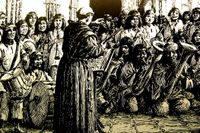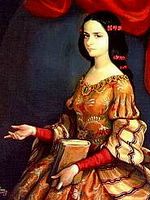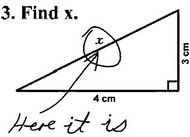Tubas and fiddles escape from the mission

This picture is behind glass at the mission in Santa Barbara and shows a monk conducting a huge band of native Californians (there are a lot more cropped out of the picture).
From the history of Mariachi:
"Although the indigenous tribes of Mexico made music with flutes, drums and whistles, there is no clear link between the indigenous music and the mariachi. The instruments originally used by the mariachi were those introduced by the Spaniards - violins, guitars, vihuelas, harps, etc. These instruments were intended to be used during masses but the criollos (Mexicans of Spanish descent) began using them to make popular music as well, much to the chagrin of the priests, since they were used to accompany some of the more scandalous, satirical or anticlerical couplets of the times."From Dirty Linen:
The Tohono O’odham have been playing their traditional music for over 200 years, ever since the missionaries recruited the Native Americans of southeast Arizona (near Tucson) to play for their Catholic masses. Later they learned the Spaniards’ social dance music so the Spaniards could hold dances. As other musicians passed through, the Tohono O’odham picked up mazurkas, chotis, two-steps, and polkas as the style transformed into what is now know as "chicken scratch."In New Mexico I heard some wonderfully wacky mazurkas and schottisches played by descendants of the "Mission Indians" as they were once called. Or if you want to hear a truly great contemporary Mexican brass band, guaranteed to get you grinning on the darkest day, try "Banda El Recodo."
Technorati Tags: Mariachi, Music, History
Labels: music



 A few of my daughter
Melina's great posts:
A few of my daughter
Melina's great posts:








0 Comments:
Post a Comment
<< Home